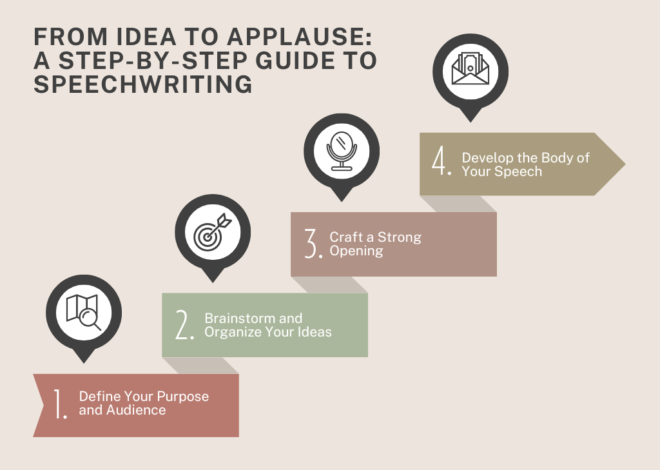
Crafting Memorable Speeches for Any Occasion
Crafting Memorable Speeches for Any Occasion
A well-crafted speech can leave a lasting impact on its audience, making an occasion truly special and unforgettable. Whether you are addressing a wedding, a corporate event, a graduation ceremony, or a public gathering, the key to success lies in effective speechwriting and delivery. This guide will walk you through the essential steps to crafting a compelling speech for any occasion.
Understanding Your Audience
The first and most crucial step in speechwriting is understanding your audience. A speech tailored to the interests, demographics, and expectations of your listeners will be more engaging and impactful. Ask yourself:
- Who is my audience?
- What do they expect from my speech?
- What emotions do I want to evoke?
- What level of knowledge do they have about my topic?
Understanding these factors will help you shape the tone, style, and content of your speech appropriately.
Defining Your Purpose
Every speech has a purpose—whether to inform, persuade, entertain, or inspire. Clearly defining your objective will give your speech a strong foundation. Ask yourself:
- What is the main message I want to convey?
- What action or thought do I want to leave with my audience?
- How does my message align with the event’s theme?
Once you have a clear purpose, it will be easier to craft a structured and focused speech.
Structuring Your Speech
A well-structured speech is easier to follow and more memorable. The standard format consists of three main parts:
1. Introduction
The introduction sets the stage for your speech. A strong opening grabs attention and establishes your connection with the audience. Consider using one of these techniques:
- A compelling anecdote
- A thought-provoking question
- A powerful quote
- A surprising statistic
For example, if you’re giving a wedding toast, you might start with a heartwarming story about the couple. If you’re delivering a business speech, a relevant industry statistic could set the tone.
2. Body
The body of your speech should contain your main points, supported by examples, stories, or data. To maintain clarity and engagement:
- Organize your ideas logically, such as chronologically, thematically, or using the problem-solution method.
- Keep each point concise and relevant.
- Use transitions to ensure a smooth flow between sections.
- Incorporate rhetorical devices like repetition, metaphors, and analogies to enhance impact.
3. Conclusion
A strong conclusion reinforces your message and leaves a lasting impression. You can:
- Summarize your main points
- End with a powerful quote or call to action
- Leave the audience with a memorable thought or challenge
For instance, if you are delivering a motivational speech, conclude with an inspiring call to action that encourages the audience to take immediate steps toward their goals.
Engaging Delivery Techniques
Writing a great speech is only half the battle—delivering it effectively is equally important. Here are some key techniques:
1. Use Natural Body Language
Your gestures, posture, and facial expressions should complement your words. Maintain eye contact to build a connection with the audience, and use purposeful movements rather than nervous fidgeting.
2. Vocal Variety and Pacing
Monotone delivery can make even the most inspiring speech dull. Vary your tone, pitch, and volume to emphasize key points. Use pauses strategically to allow important messages to resonate.
3. Practice, Practice, Practice
Rehearsing multiple times will help you feel more confident and reduce reliance on notes. Practicing in front of a mirror, recording yourself, or rehearsing with a friend can provide valuable feedback.
4. Engage Your Audience
Interaction keeps your audience invested. Depending on the occasion, consider incorporating:
- Rhetorical questions
- Audience participation
- Humor (when appropriate)
Overcoming Stage Fright
Public speaking anxiety is common, but it can be managed with the right strategies:
- Prepare thoroughly: Confidence comes from knowing your material well.
- Practice mindfulness: Deep breathing and visualization techniques can help reduce anxiety.
- Focus on the message, not on yourself: Shift attention to the value you’re providing rather than worrying about being judged.
- Start with smaller audiences: Gain confidence by practicing in front of friends, family, or small groups before addressing larger crowds.
Customizing Speeches for Different Occasions
Different events require different tones and styles. Here’s how to tailor your speech to specific occasions:
1. Weddings
- Keep it personal and heartfelt.
- Share anecdotes that highlight the couple’s journey.
- Express sincere wishes for their future.
2. Corporate Events
- Maintain professionalism while adding a personal touch.
- Keep it concise and focused on key takeaways.
- Align your message with the company’s goals and values.
3. Graduations
- Inspire and motivate the audience.
- Share personal insights or lessons learned.
- Use a mix of humor and wisdom to keep it engaging.
4. Funerals
- Speak with warmth and sensitivity.
- Share cherished memories and celebrate the life of the departed.
- Offer comfort to the audience while keeping the tone respectful.
Conclusion
Crafting a memorable speech requires a balance of preparation, structure, and effective delivery. By understanding your audience, defining your purpose, and utilizing strong storytelling techniques, you can create a speech that resonates and leaves a lasting impact. Whether it’s a joyous occasion or a solemn gathering, your words have the power to inspire, comfort, and unite people. So, the next time you step up to the podium, embrace the opportunity to craft a speech that will be remembered for years to come.


